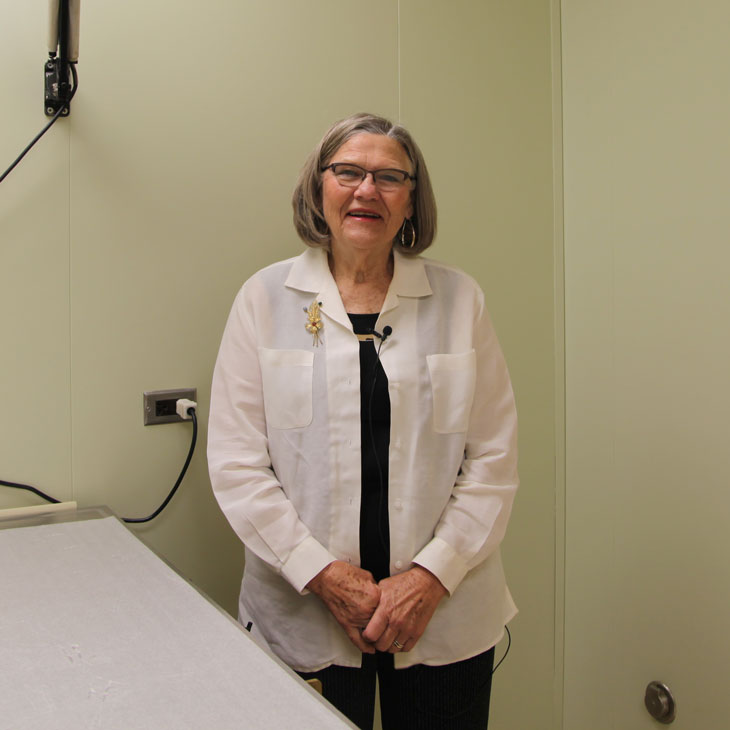
Dr. Kay Helms, 2018 Oklahoma Veterinarian of the Year
Wednesday, May 30, 2018
The Oklahoma Veterinary Medical Association named Dr. Kay Helms of Coalgate, Okla., the 2018 Oklahoma Veterinarian of the Year.
“It was very humbling,” says Helms about receiving this award. “That was probably the 45th convention that I have gone to. Every year when they read that information off, about halfway through, I usually know who it’s going to be. I didn’t ever consider that I had done anything worthy enough to be considered for that award. It’s pretty neat and having all the people there—the technicians that I’ve trained and my family being there was outstanding.”
Kay Helms grew up in South Dakota not really focused on becoming a veterinarian. She came to Oklahoma because her sister was here. While her husband struggled for a semester in OSU’s veterinary college, Helms worked for Dr. John Venable in the Department of Veterinary Pathobiology. When the couple moved away and subsequently divorced, Helms knew she could pass the classes required to be a veterinarian and returned to Stillwater to study veterinary medicine.
“I went to vet school fully intending to be a researcher,” recalled Helms. “However, my senior year was the first year that mandatory preceptorships were instituted. It was the first time that I really spent time in a practice and I fell in love with it. So when I graduated, I went to a practice in Coalgate.”
Helms graduated with her DVM degree in 1972—one of only three women in the class. At the time, the profession was male dominated with only a handful of women in each class at Oklahoma State. It would not be until the 1990s that the number of women would exceed the number of men enrolled per year.
“It was pretty challenging,” said Helms. “I will always be indebted to Dr. Paul Winsor (OSU CVM 1959) and Dr. Cliff McDonald (OSU CVM 1971). They really went out on a limb to hire a female veterinarian in southeast Oklahoma to do mixed animal practice, which was 80 percent bovine. Most of my work was done with cattle.”
As one would expect from a veterinarian of the year, it did not take long for Dr. Helms to earn clients’ respect.
“We went from some clients saying, ‘I’d rather let her die than let that woman work on her’ to being fairly well accepted and people relying on me and trusting me as much as they would a male,” added Helms.
She has several funny stories from those early years and one in particular stands out.
“I went on a farm call to Coal County. A heifer in labor needed a C-section,” explained Helms. “I instructed the people there what I needed. We were ready and they said, ‘Oh, don’t start yet. We’ve got to get Grandpa.’ So they went in the house and brought this elderly gentleman out. Got him a hay bale and sat him down on it. He had his cane, he sat there, and he watched. He didn’t say a word the whole time. When I was done, the heifer got up, the calf got up and he got up. He said, ‘Well, I’m ready to go now. I’ve seen everything—calf coming out the side of a cow and a woman delivering it.’”
Helms worked as an associate veterinarian at the Winsor Animal Clinic for five years. Then she worked as a veterinary medical officer for the U.S.D.A. in American Packing Company and Potter Sausage Company, both located in Durant, Okla. After a year, she went to Murray State College where she was instrumental in starting the veterinary technology program. She taught in the program and was director for 20 years. She retired doing relief work for the next five years.
“The last 10 or 12 years I do nothing but spay/neuter clinics—low cost spay/neuter clinics for low-income people,” said Helms. “I really have a passion for spaying and neutering because we have such a tremendous pet overpopulation not only in Oklahoma, but in the whole country. We kill between 5 million and 8 million animals a year in this country because nobody wants them. If I can prevent a couple hundred thousand of those from ever being born, then to me, that’s a worthy challenge.”
Throughout her daily routine, Helms often runs into young people who are considering a career in veterinary medicine and she offers this advice.
“Make good grades in school. Take all the math and science you can take. Volunteer or shadow in a clinic to make sure that is what you want. If you are not academically inclined or if you do not want to spend the seven or eight years it takes to go through veterinary school, consider veterinary technology. You don’t necessarily have to be a veterinarian to be part of the team.”
Good advice from one of the profession’s finest. Dr. Kay Helms also has some additional words on the back of her business card that she lives by, “Do all the good I can for all the people and animals I can every time I can for as long as I can.”
Congratulations, Dr. Kay Helms, on being the 2018 Oklahoma Veterinarian of the Year!
